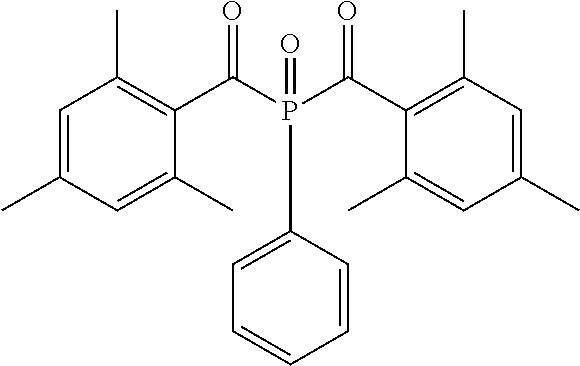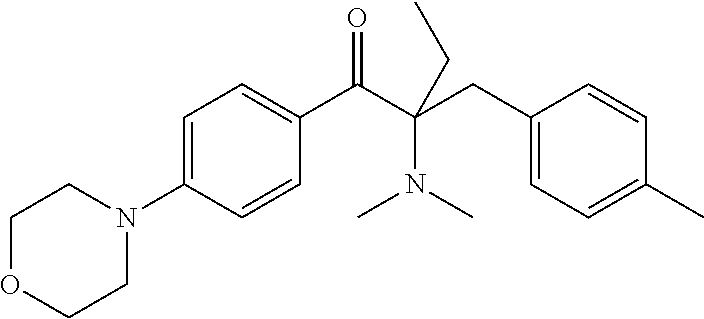Radiation curable fluids
a curable fluid and radiation technology, applied in the field of radiation curable fluids, can solve the problems of reducing the curing speed of a uv curable fluid, difficult control of the image tone in the final image, and the known degradation product of thioxanthone photoinitiators with limited stability, etc., to achieve the effect of improving the yellowing of a radiation curable fluid
- Summary
- Abstract
- Description
- Claims
- Application Information
AI Technical Summary
Benefits of technology
Problems solved by technology
Method used
Image
Examples
example 1
[0174]This Example illustrates the effect that polymeric dispersants have on the yellowing of radiation curable fluids including a vinylether acrylate monomer and a compound having a sulfonic acid group.
Preparation of Radiation Curable Fluids
[0175]A radiation curable fluid F-1 was prepared by mixing VEEA with 1 wt % of the stabilizer INHIB based on the total weight of the radiation curable fluid and adding 10 ppm of PTSA under stirring. The radiation curable fluids F-2 to F-7 were prepared by adding the polymeric dispersant in an amount according to Table 3.
[0176]
TABLE 3CurablePolymeric DispersantFluidTypeAmountF-1——F-2DB162 50 ppmF-3DB162100 ppmF-4SS35000 50 ppmF-5SS35000100 ppmF-6E7701 50 ppmF-7E7701100 ppm
Evaluation and Results
[0177]The radiation curable fluids F-1 to F-7 were kept in a closed transparent container for 2 weeks at 25° C.
[0178]The APHA was measured just after preparation (Fresh), after 1 week and after 2 weeks. The results are shown in Table 4.
[0179]
TABLE 4CurableA...
example 2
[0181]This Example illustrates the effect of the dispersant type on the viscosity and the dispersion stability of electron beam curable inkjet inks.
Preparation of Electron Beam Curable Inkjet Inks
[0182]The electron beam curable inkjet inks Ink-1 to Ink-4 were all prepared in the same manner.
[0183]First a concentrated cyan pigment dispersion was prepared by mixing for 20 minutes the 60 g of pigment Sun Fast Blue, 150 g of 40% solution of the polymeric dispersant (see Table 6) in VEEA and 1 g of the stabilizer INHIB in the monomer VEEA using a DISPERLUX™ disperser (from DISPERLUX S.A.R.L., Luxembourg). The mixture was then milled with Netzch MiniZeta wherein the internal volume was filled for 50% with 0.4 mm yttrium stabilized zirconia beads (“high wear resistant zirconia grinding media” from TOSOH Co.). The mixture was dispersed for 2 hours at a rotation speed of 3,000 rpm. During the complete milling procedure the content in the mill was cooled to a temperature of 42° C. After milli...
example 3
[0190]This Example illustrates the effect of the dispersant on the ink viscosity during storage of a UV curable inkjet ink.
Preparation of UV Curable Inkjet Inks
[0191]The UV curable inkjet inks Ink-5 and Ink-6 were prepared in the same manner.
[0192]Two concentrated cyan pigment dispersions were prepared by mixing PB15:4, a 30% solution of the dispersant in VEEA and the stabilizer INHIB for 30 minutes in VEEA in order to obtain a composition according to Table 8 using a DISPERLUX™ Dissolver (from DISPERLUX S.A.R.L., Luxembourg) and subsequently milling this mixture in a DYNOMILL ECM POLY mill (from BACHOFEN GmbH) having a bead filling of 42% with 0.4 mm yttrium stabilized zirconium oxide beads (“high wear resistant zirconia grinding media” from TOSOH Co.) for 120 minutes at a rotation speed of 10.4 m / s. After milling the dispersion was separated from the beads using a filter cloth.
[0193]
TABLE 8Componentwt %PB15:415Dispersant15INHIB1VEEA69
[0194]These concentrated cyan pigment dispersio...
PUM
| Property | Measurement | Unit |
|---|---|---|
| wt % | aaaaa | aaaaa |
| wt % | aaaaa | aaaaa |
| wt % | aaaaa | aaaaa |
Abstract
Description
Claims
Application Information
 Login to View More
Login to View More - R&D
- Intellectual Property
- Life Sciences
- Materials
- Tech Scout
- Unparalleled Data Quality
- Higher Quality Content
- 60% Fewer Hallucinations
Browse by: Latest US Patents, China's latest patents, Technical Efficacy Thesaurus, Application Domain, Technology Topic, Popular Technical Reports.
© 2025 PatSnap. All rights reserved.Legal|Privacy policy|Modern Slavery Act Transparency Statement|Sitemap|About US| Contact US: help@patsnap.com



